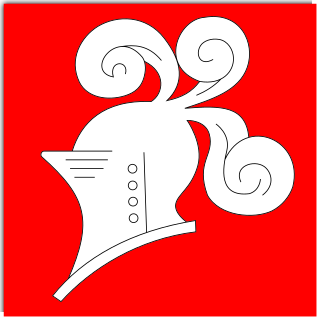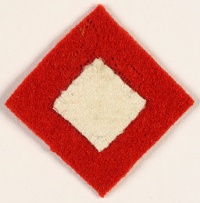
The 1st Division, formerly known as the 1st Armoured Division, is a division of the British Army. It has recently returned home from being stationed in Germany. Originally formed in November 1937 as the Mobile Division, it saw extensive service during the Second World War and was disbanded afterwards; reconstituted in 1976, it remains in service. It should not be confused with the 1st Infantry Division.

The 11th Armoured Division was an armoured division of the British Army which was created in March 1941 during the Second World War. The division was formed in response to the unanticipated success of the German panzer divisions. The 11th Armoured was responsible for several major victories in the Battle of Normandy from in the summer of 1944, shortly after the D-Day landings of 6 June 1944, and it participated in the rapid advance across France, Belgium, and the Netherlands and, later, the Rhine crossing in March 1945, and later invaded Germany. It was disbanded in January 1946 and reformed towards the end of 1950. In 1956, it was converted into the 4th Infantry Division.
The 150th Infantry Brigade was an infantry formation of the British Army that saw active service in the Second World War. A 1st Line Territorial Army brigade, it was part of the 50th (Northumbrian) Infantry Division. It served in the Battle of France and was evacuated from Dunkirk. Later it served in the Middle East and was overrun and forced to surrender during the Battle of Gazala in the North African Campaign. For almost 72 hours during the battle the 150th Brigade and the 44th Royal Tank Regiment held out against Erwin Rommel's concentrated attacks, without any support. On 1 June the German Army finally forced their surrender. The brigade was not reformed.

The 2nd Armoured Division was a division of the British Army that was active during the early stages of the Second World War. The division's creation had been discussed since the beginning of 1939, with the intent to form it by splitting the 1st Armoured Division. A lack of tanks delayed this until December 1939. For a short period after its creation, the division had no assigned units until the 1st Light Armoured Brigade was assigned to it from the 1st Armoured Division, and the 22nd Heavy Armoured Brigade from Southern Command.

The 6th Armoured Division was an armoured division of the British Army, created in September 1940 during the Second World War. In October 1940, armoured regiments within the Division, such as the 2nd Lothian and Border Horse, were supplied with Matilda MkI.I tanks, then in May 1942 Crusader MkII tanks, in August 1942 Valentine Mk.V tanks and finally in October Crusader MKIIIs. In North Africa tankers were finally put on an almost equal footing to their Panzer counterparts when the M4A2 Sherman medium tank was added to their inventory by March 1943. In November/December 1942 The division participated in the Operation Torch assault landings in Bone, closest to the Axis Forces in all the Torch landings that stretched from Morocco to the Tunisian border. In November 1942 they saw their first action as part of V Corps of the British First Army, First Allied Army in the Tunisia Campaign. In March 1943, around the same time when most of the units had been supplied with American M4A2 Shermans, the Sixth Division came under IX Corp. After Tunisia, the Division participated in the Italian Campaign as part of the British Eighth Army and ended the war in Austria, again under the command of V Corps.

The 8th Armoured Division was an armoured division of the British Army during the Second World War. It was deployed to Egypt in June 1942 but never operated as a complete formation and was disbanded in January the following year.

The 9th Armoured Division was an armoured division of the British Army, raised during the Second World War. It never saw active service during the war as a complete division.

The 22nd Armoured Brigade was an armoured brigade of the British Army that saw service during and after the Second World War. The brigade was formed on the outbreak of war on 3 September 1939 from Territorial Army (TA) armoured regiments. It saw a considerable amount of action during the war, beginning with the Western Desert Campaign where it was engaged in Operation Crusader and at the Battles of Gazala, Mersa Matruh, First Alamein and Alam el Halfa. It then joined the 7th Armoured Division for the Second Battle of El Alamein. It remained part of 7th Armoured for the rest of the war, including the campaigns in Tunisia, Italy and North West Europe. It continued in the postwar TA until 1956. The brigade's identity was re-established in the Regular Army between 1981 and 1993.
The 24th Army Tank Brigade was an armoured brigade of the British Army. It was embodied in the United Kingdom at the outbreak of the Second World War. On 1 November 1940, it was redesignated as the 24th Armoured Brigade and reorganized. In July 1942, it transferred to Egypt and took part in the Western Desert Campaign, notably the Second Battle of El Alamein. The Headquarters was disbanded in the Middle East on 1 March 1943.

The 10th Armoured Division was an armoured formation of division-size of the British Army, raised during World War II and was active from 1941–1944 and after the war from 1956–1957. It was formed from the 1st Cavalry Division, a 1st Line Yeomanry unit of the Territorial Army (TA) which had previously been serving in Palestine. The division was converted from cavalry to armour and redesignated from 1 August 1941.

The 42nd Armoured Division was an armoured division of the British Army raised during the Second World War.
The 1st Armoured Brigade, raised as the 1st Light Armoured, later the 1st Armoured Brigade Group, was an armoured formation of the British Army.
3rd Regiment Royal Horse Artillery is a regiment of the Royal Horse Artillery in the British Army. They are currently based at Albemarle Barracks, Northumberland, England.

The 7th Support Group was a supporting formation within the British 7th Armoured Division, active during the Second World War's Western Desert Campaign.
This article supplements the 7th Armoured Division article by providing order of battle information for the division through various periods of the Second World War as the organization of an armoured division was changed by the War Office. Due to the experience gained in the Middle East these changes were sometimes present in the armoured divisions there before the War Office mandated organization. Parallel changes were made in the organization in the armoured brigades. The Division frequently did not match any organization scheme due to the lack of units in the Middle East.
The British Armoured formations of World War II refers to the armoured divisions and independent armoured and tank brigades deployed by the British Army during the Second World War.

61st Light Anti-Aircraft Regiment was an air defence unit of Britain's Royal Artillery formed during World War II. Its component Territorial Army batteries, both from London, had already seen action in the Battle of France before the regiment was formed in 1940. It went on to serve with armoured formations in the Western Desert Campaign, including the Battle of Gazala. It was broken up in the Middle East in 1944 to provide infantry reinforcements for the Italian Campaign.

The 117th Light Anti-Aircraft Regiment, Royal Artillery, was an air defence unit of the British Army during World War II. Initially raised as an infantry battalion of the Royal Ulster Rifles (RUR) in 1940, it transferred to the Royal Artillery in 1942. It served in Tunisia, Malta, Sicily and Italy before being broken up in 1944 and the gunners converted back into infantrymen.











